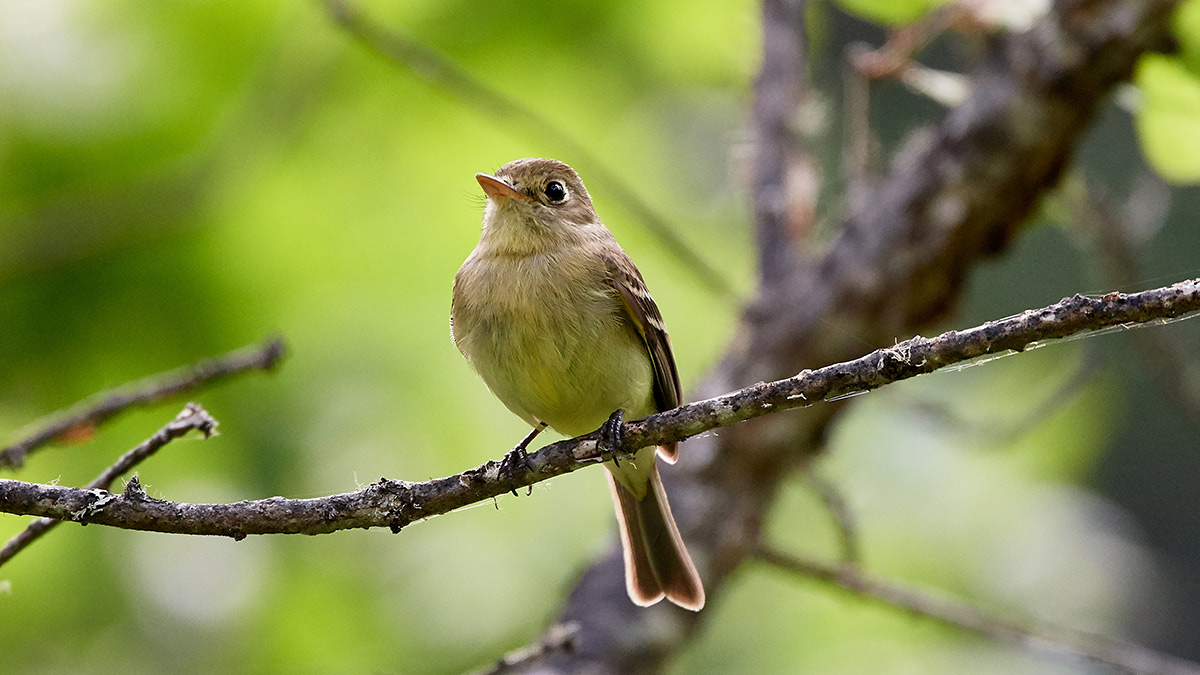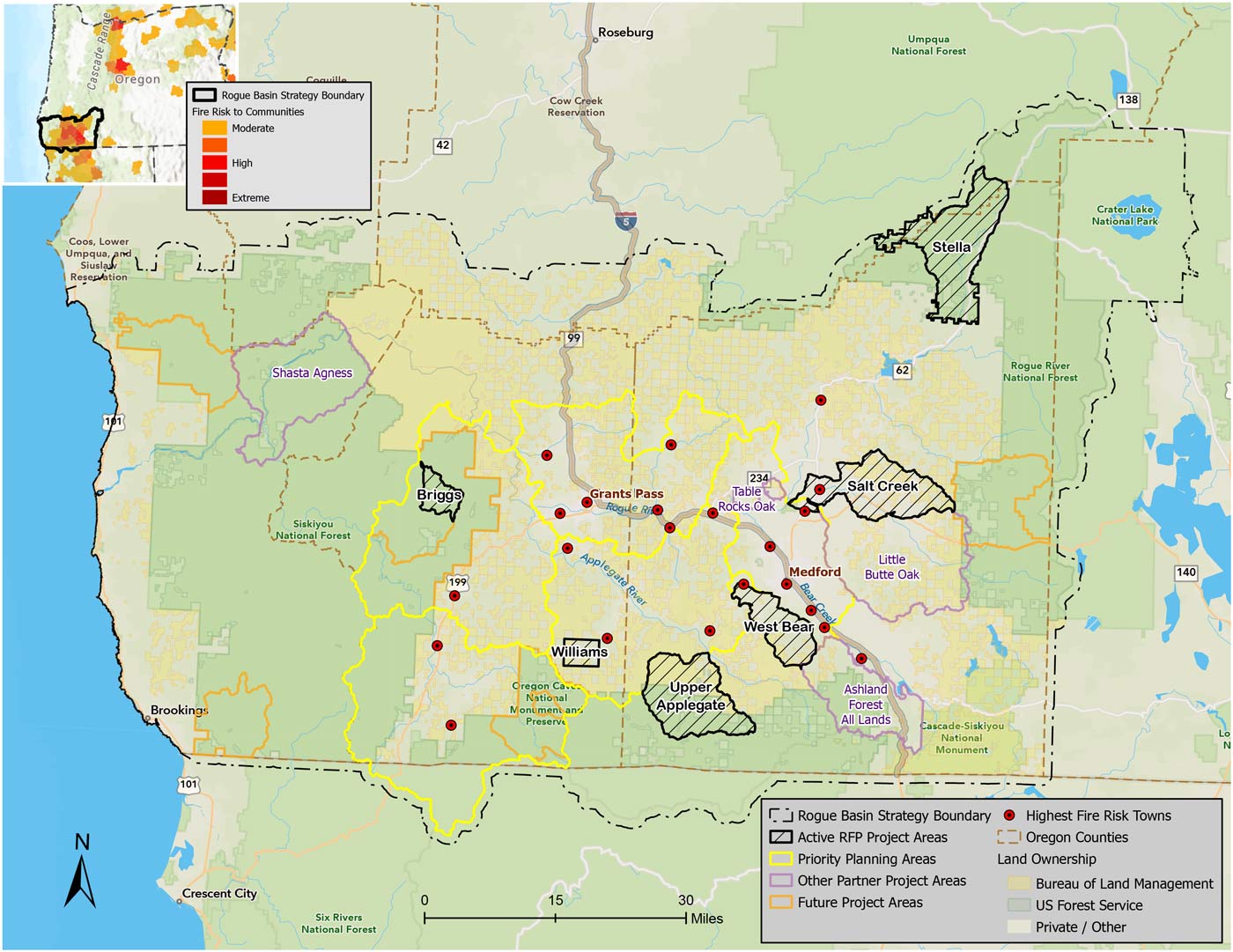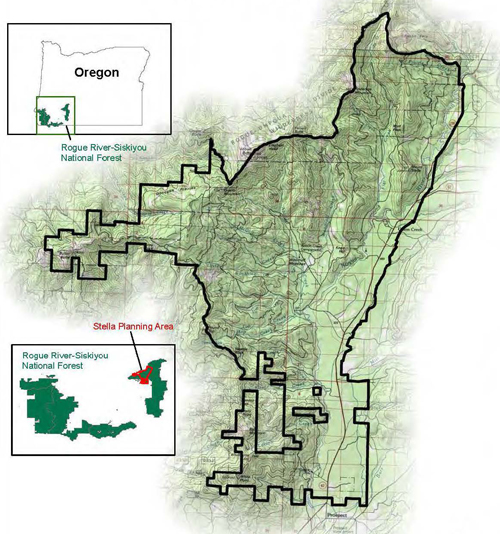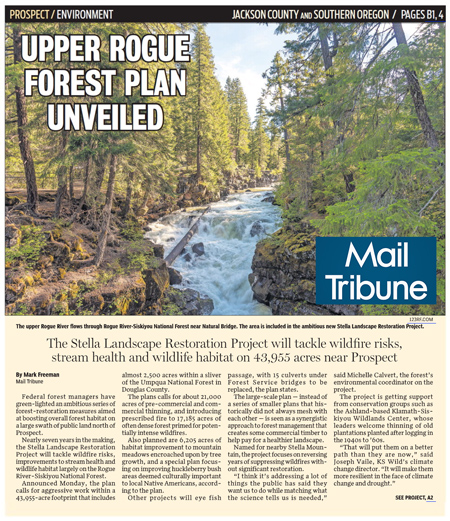Stella Landscape Restoration Project
The Stella Landscape Restoration Project area is located mostly on the High Cascades Ranger District in the Rogue River-Siskiyou National Forest (RRSNF) and a small portion of the Tiller Ranger District on the Umpqua National Forest (UNF).
As a result of over a century of fire suppression, extensive logging, and the removal of indigenous peoples, the forest and meadow systems in the Stella project area have been degraded by logging impacts, roads, and increasing forest density.
To improve wildlife habitat, and forest health and build ecosystem resilience to wildfire, the Stella Project will strategically apply ecological thinning (both non-commercial and commercial) and prescribed fire to achieve restoration goals across a 43,955-acre footprint.
Where:
When:
Ecological thinning is slated to begin in 2023, with treatments anticipated through 2027.
Why:
To reduce wildfire risks and address needed improvements to stream health, wildlife habitat, and roads.
Scope:
41,509 acres on the RRSNF + 2,500 acres on the UNF for a total 43,955-acre footprint
For the Stella Landscape Restoration Project Area, there is a need to:
- Improve forest resilience by reducing the risk of loss from uncharacteristic wildland fire and/or insect and disease outbreaks by restoring forest structure, composition, and density.
- Reduce risk to local communities from wildland fire.
- Enhance wildlife habitat and improve aquatic ecosystems.
- Provide a sustainable flow of goods and services that contribute to Forest targets and provide social and cultural opportunities.
- Restore culturally significant plants and habitats and maintain habitats for rare plant populations.
The Stella Restoration Project spans 41,509 acres on the Rogue River-Siskiyou National Forest, with an additional 2,500 acres on the Umpqua National Forest.
The project area includes 21,000 acres of pre-commercial and commercial thinning and re-introducing prescribed fire to 17,185 acres of often dense forest primed for potentially intense wildfires.
Special habitats across the Stella Landscape Restoration Project Area include predominately open to semi-open habitats, specifically meadow, oak habitat (savanna and woodland), open riparian meadow, and huckleberry patches. All of these are unique features of the Rogue River- Siskiyou and Umpqua National Forests and have been in decline over the last several decades across the Project Area.
In collaboration with the Cow Creek Band of Umpqua Indians, the Stella Project will also help restore and protect important cultural resources and subsistence foods within an identified Huckleberry Patch Special Interest Area (SIA).
On the Rogue River-Siskiyou National Forest, these special habitat restorations will occur on approximately 4,581 acres within the larger project footprint.

Surveys conducted by the Klamath Bird Observatory in the Stella Project area noted several species, including Brown Creeper, Hammond’s Flycatcher, and Pacific Wren, may benefit from forest thinning treatments.
Medford Mail Tribune: Upper Rogue forest plan unveiled
By Mark Freeman, August 23, 2022.
“The large-scale plan — instead of a series of smaller plans that historically did not always mesh with each other — is seen as a synergistic approach to forest management that creates some commercial timber to help pay for a healthier landscape.
Named for nearby Stella Mountain, the project focuses on reversing years of suppressing wildfires without significant restoration.
“I think it’s addressing a lot of things the public has said they want us to do while matching what the science tells us is needed,” said Michelle Calvert, the forest’s environmental coordinator on the project.”
RFP Project Areas
RFP has identified six projects across the Rogue Basin. These high-priority areas, spanning public land and private tracts, are critically important for reducing the risks of extreme wildfires, promoting forest health, and restoring resilience to our landscape. The work began in the Applegate and Illinois Valleys in 2020 and continues into 2025.

The Upper Briggs Restoration Project on the Wild Rivers District in the Illinois Valley supports diverse habitats and forest conditions. This ridge burned in the Klondike/Taylor fire, but from ridge to stream, one encounters legacy trees to protect, dense understories to be thinned and chaparral patches intermixed. The ridgeline is important for managing fires moving from wildlands toward Illinois Valley communities.
The Williams Project near the community of Williams in Josephine County is focused on reducing fuels and improving forest habitat through restoration treatments on federal and private lands in an all-lands effort bringing together the BLM and NRCS with the RFP to demonstrate restorative wildfire risk reduction. Together, we are working toward the landscape-vision of the RBS.
The West Bear Project addresses the need for wildfire fuels reduction immediately adjacent to the cities of Jacksonville, Phoenix, Talent, and Medford. The 27,000-acre project area within the wildland urban interface west of Bear Creek and the I-5 corridor is one of the most at-risk locations for wildfire in Oregon.
The 50,000-acre USFS and BLM Upper Applegate Watershed Project (UAW) is located in the Applegate Valley with over 18,000 acres of planned restoration treatments designed during a three-year community planning process convened by the Siskiyou Mountains Ranger District of the RRSNF. Some 3500 acres are scheduled by RFP to be completed by 2025. The UAW is one of the highest priority areas for restoration under the RBS.
The Stella Landscape Restoration Project project occurs in the most productive corner of the Rogue Basin, where the lack of low-intensity fire and past management has resulted in high-density stands and declining forest health. To improve wildlife habitat and forest health and build ecosystem resilience to wildfire, the Stella Project will strategically apply ecological thinning (both non-commercial and commercial) and prescribed fire to achieve restoration goals across a 43,955-acre footprint.
The Salt Creek Project planning area is large but RFP work with the BLM starts with a small footprint of fuels treatments in oak woodlands. The treatments will demonstrate ecological restoration under the RBS in these dry but diverse oak habitats and help reduce wildfire risks near the communities of Eagle Point.
After 7 years of intense work, the Stella Final Record of Decision is signed for the landscape project. This is an extremely important piece of stewarding public lands in southwest Oregon for many years to come.
Merv George, Jr., Rogue River-Siskiyou National Forest, Forest Supervisor


